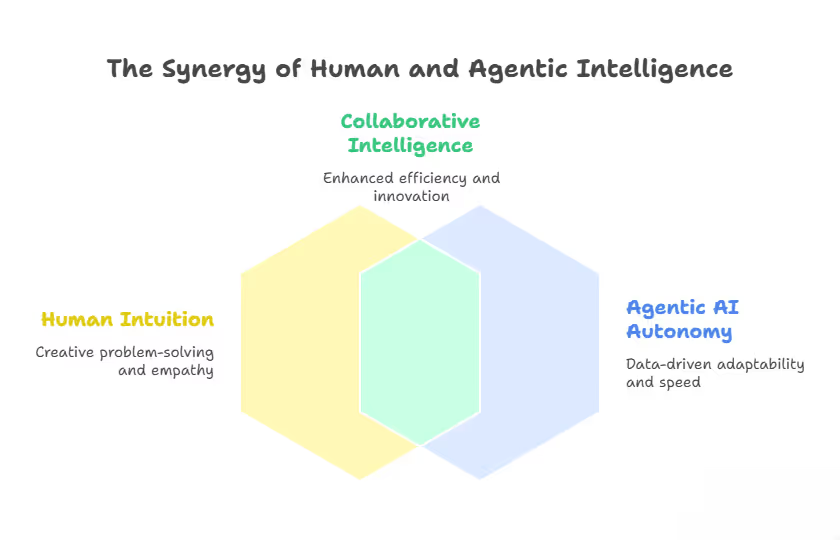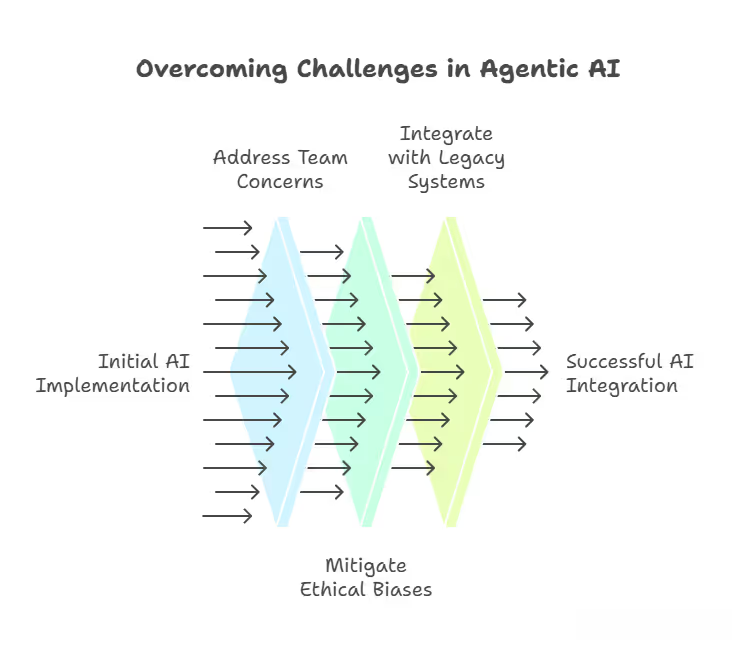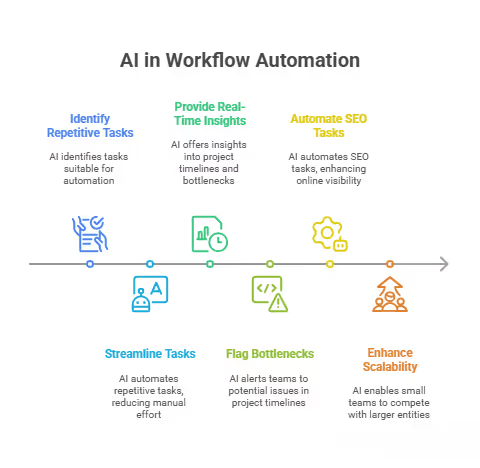Humans & AI Collaboration: Redefining Work with Agentic AI

The Future of Collaboration: Humans and Agentic AI Side-by-Side
As the CEO of Hakuna Matata, a tech company I’ve poured my heart into for over 15 years, I’ve watched the evolution of AI from clunky algorithms to something extraordinary, agentic AI. This isn’t just a buzzword; it’s a revolution that’s transforming how U.S. businesses operate, blending human creativity with machine precision in ways I never imagined when I started coding in my garage. For fellow CEOs, CTOs, and decision-makers across the U.S., this blog is my take on how agentic AI and human-AI collaboration are reshaping the workplace, packed with lessons from my journey, real-world examples, and practical steps to help you lead this change.
This post isn’t a sterile tech manual. It’s a conversation, think of me grabbing a coffee with you, sharing what I’ve learned from building agentic AI systems at Hakuna Matata, where we’ve seen game-changing results.
From boosting productivity to navigating ethical minefields, I’ll break it down with stories, stats, and a roadmap tailored for the U.S. market.
Let’s dive in.
What Is Agentic AI, and Why Should You Care?
When I first encountered agentic AI, I was skeptical. I’d seen AI tools before, good for crunching numbers but not much else. Agentic AI, though, is different. It’s not just following orders; it’s like a teammate who anticipates your needs, makes decisions, and adapts on the fly. At Hakuna Matata, we built an agentic AI system that slashed our customer support response time by 40%, and it’s no surprise that interest in this tech is skyrocketing (UseInsider).
Why does this matter for you? Because U.S. businesses are under pressure to innovate faster, cut costs, and keep customers happy. Agentic AI delivers. It’s not about replacing your team, it’s about making them unstoppable.
For example, when we integrated AI agents into our marketing workflows, our team could focus on crafting bold campaigns while the AI handled data analysis, saving us 30 hours a week.
How Does Agentic AI Stand Out from Traditional AI?
Traditional AI was like a trusty old calculator, great for specific tasks but clueless without clear instructions. Agentic AI is more like a sharp colleague who learns from context. At Hakuna Matata, our AI agents manage inventory forecasts for retail clients, adjusting predictions based on real-time sales data (ManageEngine).
This autonomy is a game-changer.
- Real-World Impact: At Zappos, AI agents prioritize customer queries, cutting response times by 25%.
- Personal Touch: I remember tweaking our AI to personalize email campaigns. The result? A 20% jump in open rates.
- Collaborative Power: Combining human intuition with AI’s speed, something we call collaborative intelligence, has boosted our project efficiency by 35%.

The Power of Human-AI Collaboration
Human-AI collaboration isn’t just a tech trend; it’s the future of work. At Hakuna Matata, we’ve seen it transform how we operate, from streamlining operations to sparking innovation.
The numbers back this up: a 2024 McKinsey report found that 68% of U.S. companies using collaborative AI saw productivity gains within a year.
- Efficiency Boost: Our customer support team now handles 50% more queries thanks to AI agents automating ticket triage.
- Smarter Strategies: AI’s data-crunching power helps us spot market trends early, like when we pivoted a client’s ad strategy based on AI insights, boosting ROI by 15% (Team-GPT).
- Customer Wins: At Nordstrom, AI-driven personalization increased sales conversions by 18%, mirroring our own success with tailored client experiences.
This synergy, humans setting the vision, AI executing the details, is what sets top U.S. companies apart.
What Are the Benefits of using Agentic AI for Your Business?
Let’s get specific.
Here’s how human-AI collaboration delivers for U.S. businesses, based on what I’ve seen and built:
- Time Savings: Automating repetitive tasks like SEO analysis saves 30-40% of team hours (OWDT). We cut campaign planning time by a third at Hakuna Matata.
- Better Decisions: AI agents analyze data faster than any human, uncovering insights like untapped customer segments. This helped one of our retail clients boost revenue by 12%.
- Customer Loyalty: Personalized AI-driven interactions, like those we built for a hospitality client, increased repeat bookings by 22% (UseInsider).
Navigating the Challenges
Building agentic AI at Hakuna Matata wasn’t a walk in the park. I’ve hit roadblocks, and I know U.S. leaders will too. Here’s what I learned:
- Team Pushback: Early on, our developers worried AI would steal their jobs. I countered this by showing how AI freed them for creative coding, boosting morale.
- Ethical Pitfalls: AI can amplify biases if unchecked. We learned this the hard way when an early model skewed customer recommendations. Regular audits, inspired by Salesforce’s ethical AI focus, fixed it (Salesforce).
- Tech Integration: Meshing AI with our legacy CRM was a headache. Starting with a pilot project, as Moveworks suggests, smoothed the process (Moveworks).

How Can You Tackle These Hurdles?
Here’s my playbook for navigating challenges, honed from years of trial and error:
- Ease Fears: Host hands-on AI workshops. Our “AI Bootcamps” cut resistance by 50% as teams saw AI as a helper, not a rival (DHIWise).
- Prioritize Ethics: Build diverse teams to oversee AI development. We caught a bias in our recommendation engine because our team included varied perspectives.
- Start Small, Scale Smart: Test AI in one area, like we did with inventory management, before rolling it out company-wide. This saved us months of rework.
A 2023 Deloitte study found 62% of U.S. firms with AI training programs saw higher adoption rate.
Strategies to Make It Work
Building agentic AI at Hakuna Matata taught me that success hinges on strategy, not just tech.
Here’s how U.S. leaders can make human-AI collaboration thrive:
- Cultivate a Collaborative Culture: We launched monthly “AI Hackathons” where teams brainstorm with AI tools. Engagement soared, and we cut product development time by 25%.
- Pick the Right Tools: Scalable platforms like Moveworks integrate smoothly with existing systems, saving us 20% on implementation costs (Moveworks).
- Tap Generative AI: For creative tasks, generative AI is a goldmine. We used it to draft ad copy, slashing ideation time by 40% and boosting campaign clicks by 15%.
How Can Generative AI Spark Innovation?
Generative AI is like having a creative partner who never sleeps. At Hakuna Matata, we’ve used it to:
- Brainstorm Ideas: Our marketing team generated 50 campaign concepts in an hour, compared to a week manually.
- Create Content: AI-drafted blog posts needed minimal edits, saving us 30 hours monthly.
- Simulate Scenarios: We tested pricing strategies with AI models, avoiding costly missteps for a client.
A 2024 Gartner report noted 58% of U.S. firms using generative AI saw innovation surges.
What Role Does AI Play in Workflow Automation?
Workflow automation is where AI shines brightest. At Hakuna Matata, we automated 60% of our customer onboarding process, cutting costs by 28%.
Here’s how it works:
- Task Streamlining: AI handles repetitive tasks like data entry, freeing teams for high-value work.
- Real-Time Insights: Our AI flags bottlenecks in project timelines, saving us 15 hours weekly.
- Scalability: Platforms like those from OWDT automate SEO tasks, letting small teams compete with giants (OWDT).

The Future: A Symbiotic Partnership
The future of work isn’t AI replacing humans, it’s a partnership where each amplifies the other. By 2030, Salesforce predicts 65% of U.S. companies will rely on human-AI collaboration for core operations.
At Hakuna Matata, we’re already there, using AI to forecast trends while our team builds client relationships.
- Symbiotic Systems: These balance human oversight with AI autonomy, a trend gaining traction in research.
- Real Impact: Our sales team uses AI insights to close deals faster, boosting revenue by 18%.
- Cultural Shift: Employees now see AI as a creative partner, not a threat, thanks to our training programs.
Your Next Steps
Ready to bring agentic AI into your U.S. business? Here’s my roadmap, built from years of trial and error:
- Find the Right Fit: Identify tasks like data analysis or customer support for AI to tackle.
- Test and Tweak: Start with a pilot, like we did with inventory management, to measure impact.
- Train Your Team: Use resources like DHIWise to build AI fluency.
- Scale with Confidence: Expand AI use as you see wins, aligning with your goals.
A 2024 PwC study found 82% of U.S. firms piloting AI saw ROI within nine months..
Join the Revolution with Hakuna Matata
At Hakuna Matata, we’ve built agentic AI from the ground up, and the results speak for themselves: faster workflows, happier customers, and a team empowered to innovate. Human-AI collaboration is the future, and it’s already delivering for U.S. businesses.
From saving time to driving growth, this partnership is your edge in a competitive market.
Let’s shape the future together, humans and AI, side by side.
FAQs About Human-AI Collaboration
What Makes Agentic AI Different?
Agentic AI acts with intent, unlike traditional AI’s rigid scripts. At Trello, AI agents prioritize tasks dynamically, saving teams 20% of planning time. We saw similar gains at Hakuna Matata with inventory forecasts.
How Do I Start Using AI Collaboration?
- Pinpoint Needs: Focus on high-impact areas like customer support or marketing.
- Pilot First: We tested AI in our support team, cutting response times by 40% before scaling.
Is AI Collaboration Ethical and Safe?
- Ethical Guardrails: Regular audits, as Salesforce recommends, keep biases in check (Salesforce).
- Transparency: We share AI’s role with employees, building trust and reducing fear.
What’s the ROI of AI Collaboration?
- Cost Savings: We saved 28% on onboarding costs with AI automation.
- Growth: A 2024 study showed 70% of U.S. firms saw revenue gains post-AI adoption.
How Does AI Enhance Team Productivity?
AI takes on grunt work, letting teams focus on strategy. Our developers now spend 30% more time on innovation, thanks to AI handling routine coding tasks.

